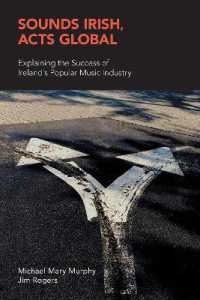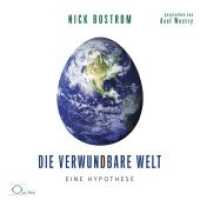- ホーム
- > 洋書
- > 英文書
- > Performing Arts
Full Description
The history of dance theory has never been told. Writers in every age have theorized prescriptively, according to their own needs and ideals, and theorists themselves having continually asserted the lack of any pre-existing dance theory. Dance Theory: Source Readings from Two Millenia of Western Dance revives and reintegrates dance theory as a field of historical dance studies, presenting a coherent reading of the interaction of theory and practice during two millennia of dance history. In fifty-five selected readings with explanatory text, this book follows the various constructions of dance theories as they have morphed and evolved in time, from ancient Greece to the twenty-first century.
Dance Theory is a collection of source readings that, commensurate with current teaching practice, foregrounds dance and performance theory in its presentation of western dance forms. Divided into nine chapters organized chronologically by historical era and predominant intellectual and artistic currents, the book presents a history of an idea from one generation to another. Each chapter contains introductions that not only provide context and significance for the individual source readings, but also create narrative threads that link different chapters and time periods. Based entirely on primary sources, the book makes no claim to cite every source, but rather, in connecting the dots between significant high points, it attempts to trace a coherent and fair narrative of the evolution of dance theory as a concept in Western culture.
Contents
List of Illustrations
Preface
Acknowledgments
Introduction: Dance Theory as a Problem in Dance History
Chapter 1. Dance Theory to ca. 1300
1.1. Plato
1.2. Aristotle
1.3. Plutarch
1.4. Lucian of Samosata
1.5. Johannes de Grocheio
Chapter 2. The Renaissance
2.1. Domenico da Piacenza
2.2. Antonio Cornazano
2.3. Guglielmo Ebreo
2.4. Thoinot Arbeau
2.5. Fabritio Caroso
Chapter 3. The Seventeenth Century
3.1. François De Lauze
3.2. Claude-François Menestrier
Chapter 4. The Early Enlightenment: German and English Dance Theory, 1703-1721
4.1. Samuel Rudolph Behr
4.2. Johann Pasch
4.3. Gottfried Taubert
4.4. John Weaver
Chapter 5. Dance Theory from Feuillet to the Encyclopédie
5.1. Giambatista Dufort
5.2. Bartholome Ferriol y Boxeraus
5.3 Pierre-Alexandre Hardouin
5.4. Louis de Cahusac
Chapter 6. Divergent Paths: Noverre
6.1. Jean-Georges Noverre
6.2. Giovanni-Andrea Gallini
6.3. Johann George Sulzer
6.4. Gennaro Magri
6.5. Charles Compan
Chapter 7. The Nineteenth Century and Fin de siècle: Practice Ascendent
7.1. Jean-Étienne Despréaux
7.2. Carlo Blasis
7.3. Arthur St. Léon
7.4. G. Léopold Adice
7.5. Friedrich Albert Zorn
7.6. Eugène Giraudet
7.7. Edmond Bourgeois
Chapter 8. The Twentieth Century: Modernist Theory
8.1. Rudolf von Laban
8.2. Margaret N. H'Doubler
8.3. African American Dance Theory I
8.3a. Zora Neale Hurston, and 8.3b. Katherine Dunham
8.3c. Robert Farris Thompson
8.3d. Brenda Dixon Gottschild
8.4. Martha Graham
8.5a. Alwin Nikolais, and 8.5b. Murray Louis
8.6a. Flavia Pappacena, and 8.6b. Susanne Franco
Chapter 9. Postmodern Dance Theory and Anti-Theory
9.1a. Merce Cunningham, and 9.1b,c. Yvonne Rainer
9.2. Susan Leigh Foster
9.3. André Lepecki and Jenn Joy
9.4. African American Dance Theory II
9.4a. Thomas F. DeFrantz, and 9.4b. Anita Gonzalez
9.4c. Halifu Osumare
9.4d. Nadine George-Graves
9.4e. Philipa Rothfield and Thomas F. DeFrantz
9.5a. Susan Leigh Foster, and 9.5b. P.A.R.T.S. (Performing Arts Research and Training Studios)
9.6a. Kent De Spain, and 9.6b. Janet Lansdale
9.7. Gabriele Brandstetter
Appendix: Table of Dance Periodization
Bibliography
Index








